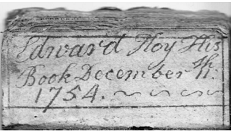1734 London Almanac found in old Hatfield Pub.
 21 February 2018
21 February 2018
Miniature eighteenth century Almanac found in the Eight Bells tavern in old Hatfield.
News from Hatfield Local History Society
During building work at the Eight Bells pub in 1970, a miniature almanac, measuring just 2 x 1.25 inches, was found secreted away inside a dowel hole in a timber beam.
In December 2017 it was taken from its display case inside the pub by historians of the University of Hertfordshire who carefully scanned every page. The results are to be uploaded on the Our Hatfield website in March.
Kind information from Shannon Struble, an antiquarian bookseller in the USA, described it as “an uncommon London Almanac” which was printed in 1734 by the Company of Stationers. It recorded such things as the church calendar; astrological dates, sunrise and sunsets, lists of monarchs from 1066 and serving Lord Mayors of London and Sheriffs from 1709. There are a few illustrations including one figure wearing a large, winged hourglass on his head, perhaps to denote the passage of time. There were also depictions of King George II and the publisher’s own coat of arms.
The page for March (above) shows that the week beginning March 6 was an ‘Ember Week’. These were four weeks in the church calendar, spaced equally throughout the year - one for each season. The Wednesday, Friday and Saturday of that week were set apart for fasting and giving thanks for the gifts of nature. The modern day Harvest Festival perhaps has a connection to these forgotten traditions.
Unfortunately the almanac’s cover was missing but 38 pages are still intact.
Ms Struble noted that it had been “…disbound and sewn back together..” rather than glued, as it originally would have been. And this was the likely reason for some intermittent blank pages inside. However, it is on these pages that we learn something about its past owner.
Handwriting on a blank page informs that this tiny book was given to Edward Hoy by his sister Mary Hoy in 1754. By then, the book was 20 years old. There were also a couple of childlike drawings of animals on other blank pages.

A part history of the Hoy’s is also interesting. The grandfather of the above children was an Edward Hoy who died in 1728. He was a fellmonger – a dealer in animal skins for tanning. He would have obtained them from a local butcher or abattoir in the Old Town and prepared them at his shop in Batterdale - which street also had a tannery. The original Batterdale was about 50 yards south of the pub and opposite Church Street.
A 19th century conveyance relating to property in Fore Street refers to, “…all that messuage or tenement adjoining to the Brewhouse in the possession of Edward Hoy, fellmonger, together with the barn and outhouse, piece of garden ground and two stables adjoining to the great barn and yard in common”. Is it possible that old Edward’s brewhouse provided the beer for his own pub? And if so, was that pub the Five Bells (later known as the Eight Bells)? Did he live there? We don’t know, but it is tempting to think that there was some family connection which resulted in the almanac being found in the building.
However, we do know he had two sons: Charles and Edward Jnr. Charles and his wife Elizabeth had a son, Edward, and a daughter, Mary, who were baptised in 1741 and 1744 respectively; and these must be the siblings referred to in the almanac. They would have been aged 14 years and 10 years old when Mary gifted it to her brother in 1754. They both died relatively young, predeceasing their father, Charles, who died in 1782 and their uncle, Edward Hoy Jnr, who lived on until 1783. He was a breeches and glove maker, operating from his father’s old fellmonger workshop in Batterdale.
Jon Brindle
Hatfield Local History Society
With thanks to: Robin Harcourt Williams, Prof Owen Davies, Shannon Struble and the WEA.
